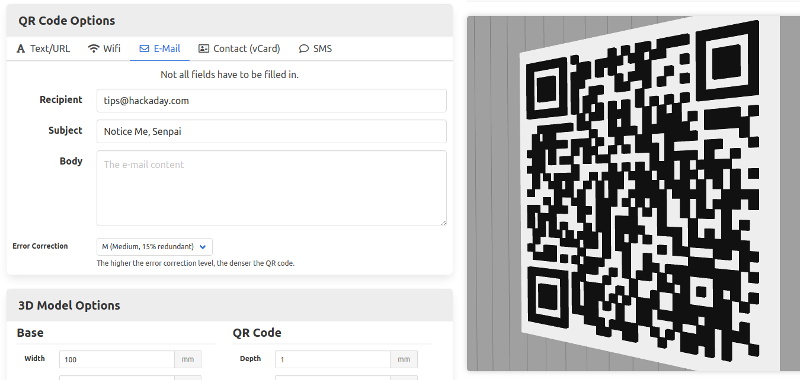Since most people are carrying a camera-equipped computer in their pockets these days, QR codes can be a great way to easily share short snippets of information. You can put one on your business card so people can quickly access your contact information, or on your living room wall with your network’s SSID and encryption key. The design of QR codes also make them well suited to 3D printing, and thanks to a new web-based tool, you can generate your own custom STL in seconds.
Created by [Felix Stein], the website provides an easy to use interface for the many options possible with QR codes. Obviously you have full control over the actual content of the code, be it a simple URL or a something more specific like a pre-formatted SMS message. But you can also tweak physical parameters like size and thickness.
Once you’re happy with the 3D preview, you can have the website generate an STL for either single or multi-extrusion printers. For those of us who are puttering along with single extruder machines, you’ll need to swap the filament color at the appropriate layer manually. With so many variables involved, you’ll also need figure out which layer the swap should happen on your own.
Incidentally, this is an excellent example of where STL leaves something to be desired. When using a format like 3MF, color and material information could be baked right into the model. Once opened in a sufficiently modern slicer, all the tricky bits would automatically sorted out. Or at least, that’s what Prusa Research is hoping for.
















This is great for those times when printing on a piece of paper isn’t cool enough for you.
QR as art instead of information.
Only if it leads to a duck roll.
Challenge Accepted
And, changing the password requires warming up the 3d printer and starting a 2-hour print, instead of just printing out a piece of paper that takes about 5 seconds to print.
It’s not a great idea to 3d print wifi access qr codes. Waste of plastic.
Agreed. Unless you are making a serial number plate or something similar that needs to be more durable than a sticker, this is a massive waste.
Trust me, for all the patients who need the wifi code, I’d rather 3D print it with an angled support so nobody has to touch it rather than printing an ugly paper that won’t last.
I don’t change the password quite often, and printing something like that might need like 30-45min, costing a few cents and using one or two grams of recyclable plastic. Seems more legit to me than many of the useless-but-pleasuring things we often print…
Considering how bad some people are about security disciplines. I wonder how often stuff like this gets used to spread malware.
Often
Good point, who would dare scan this one now?
http://i.imgur.com/6AnLddq.png
Lol…. My qr scanner app shows me the contents before asking me to do whatever the barcode wants. It’s hard to be fleeced if you have to say yes after you’ve seen the attack for what it is in order to be attacked.
Perfect for a keyring, though it might wise to put in limited contact information, like contact number & email when they get lost
Or… Just print in text…. The information density would be roughly the same but not require extra steps. Many people would see that QR and not be bothered to make the effort to read it. Whereas if it’s plain readable text saying “call this number if found, Xxx-xxx-xxxx, $ reward for safe return to owner.” That makes it much more likely your keys make it back to you.
exactly, I have never in my life scanned a QR code with my phone, even though I work with QR and datamatrix codes every single day. If I see your keys im going to think your a dumbass, then see the QR code, then know your a dumbass, and drop them in the closest mailbox … and you know the post office ain’t going to scan that either
FWIW, any lithophane program will do this. You can even drag-n-drop a QR Code image directly in Cura and start printing one in seconds. (You can either color it later with markers, or take the time to add in a pause instruction and print the top layers in black.)